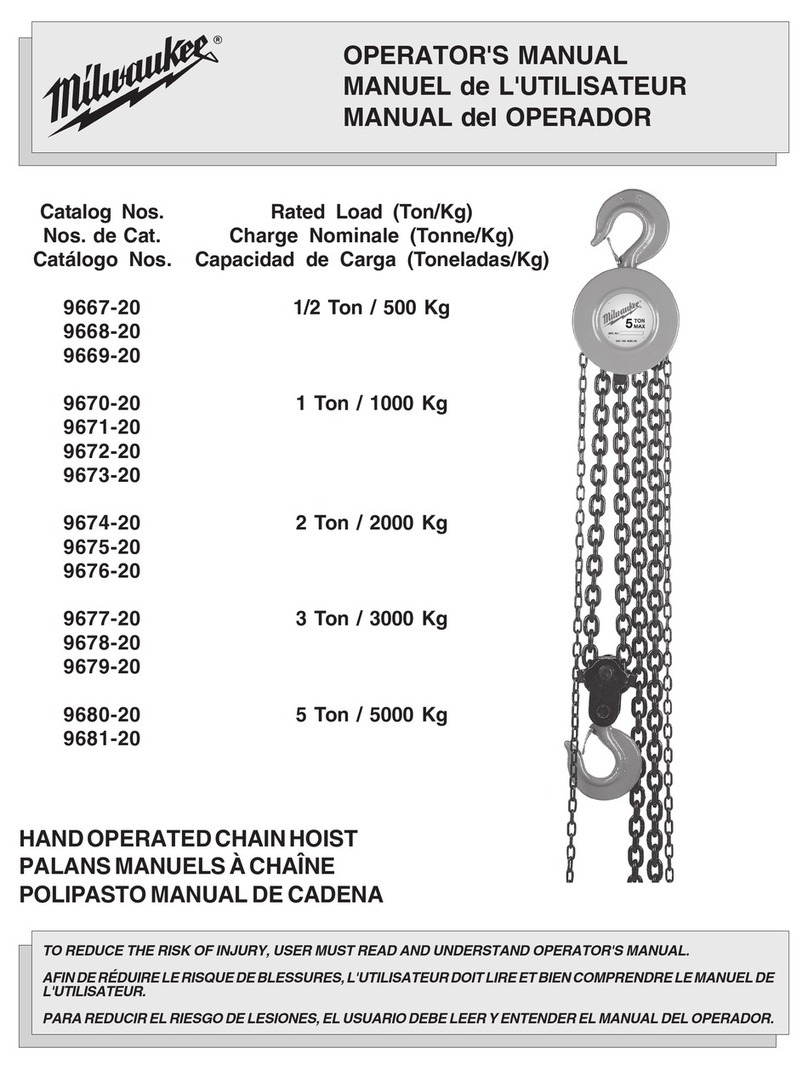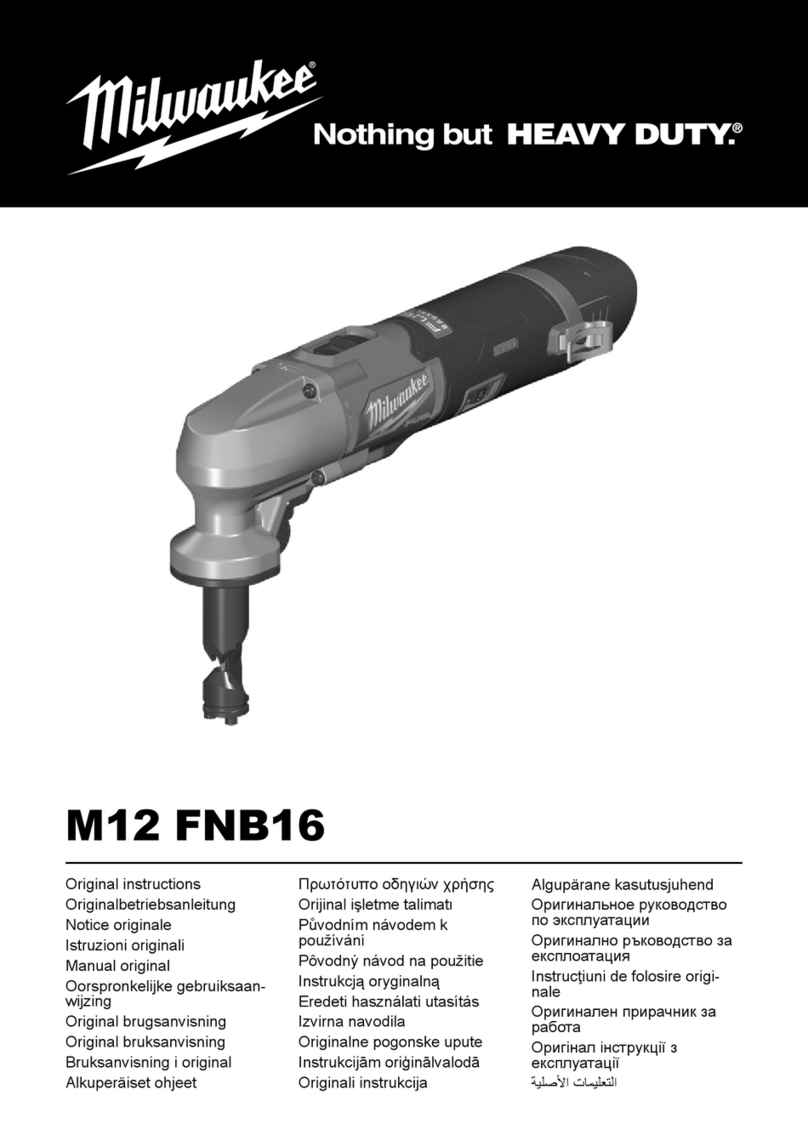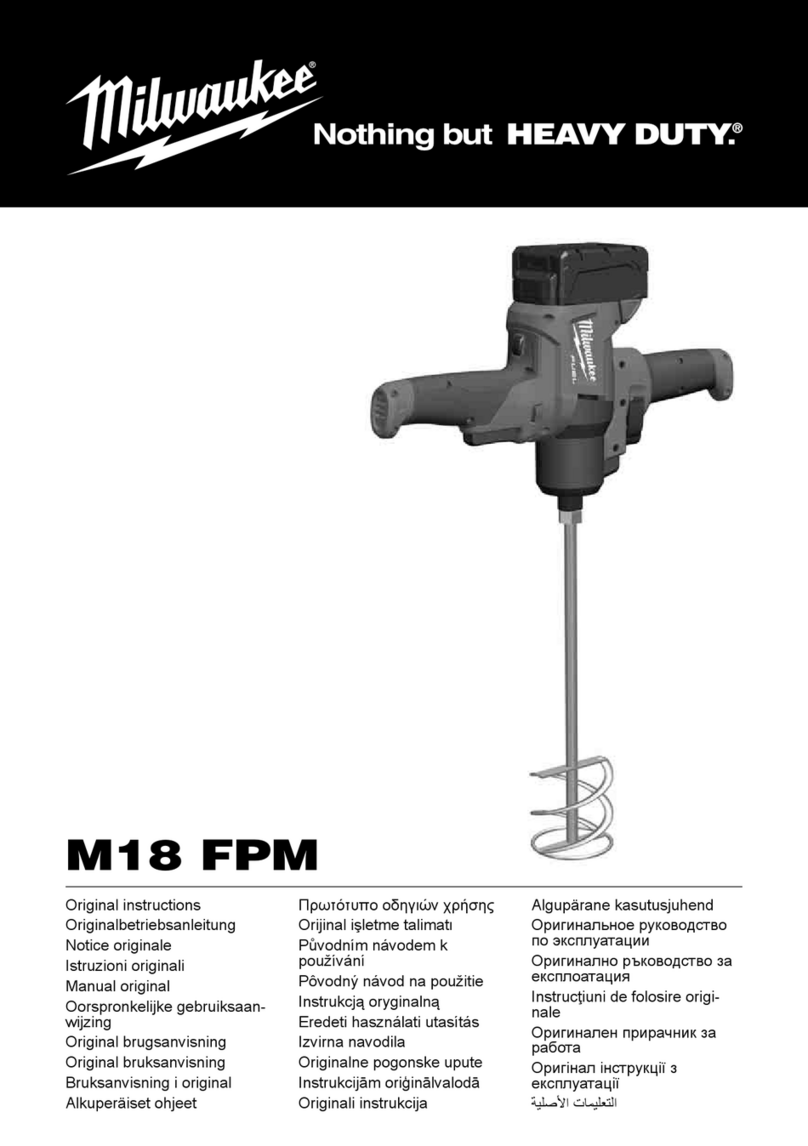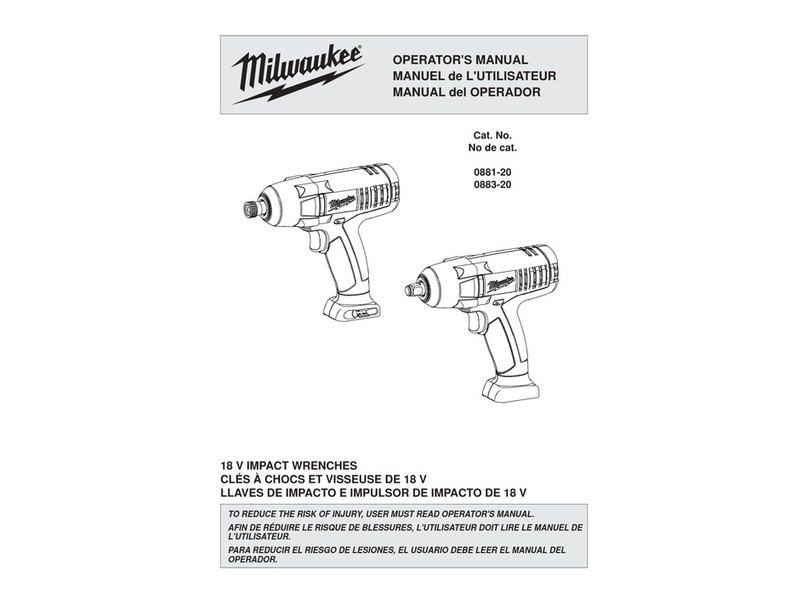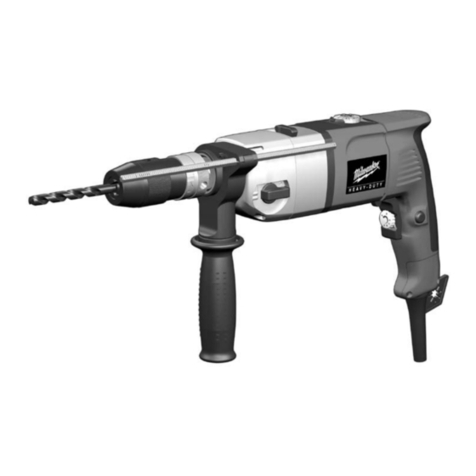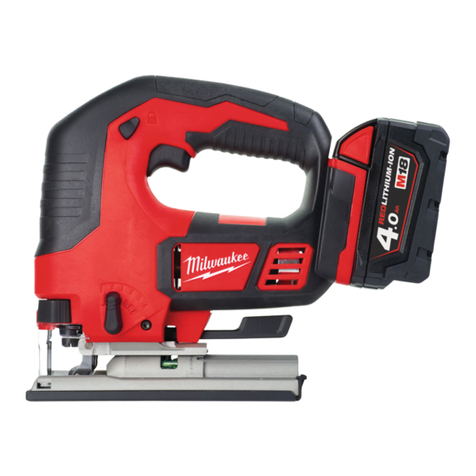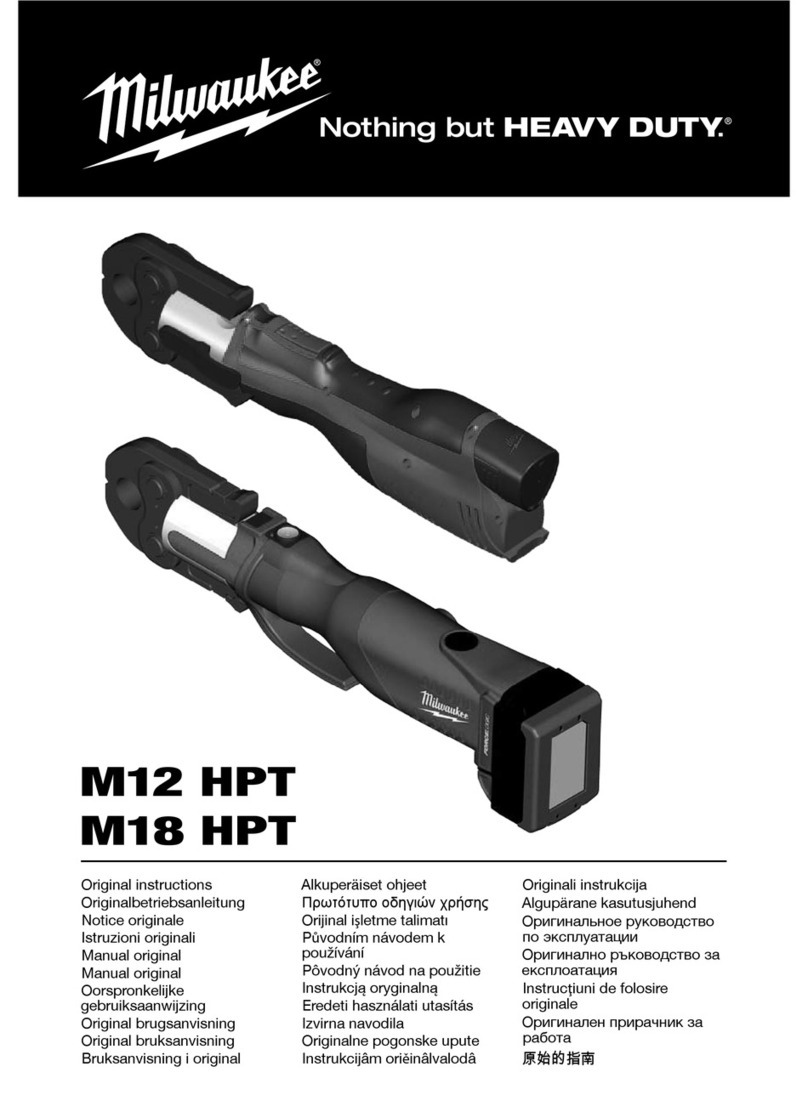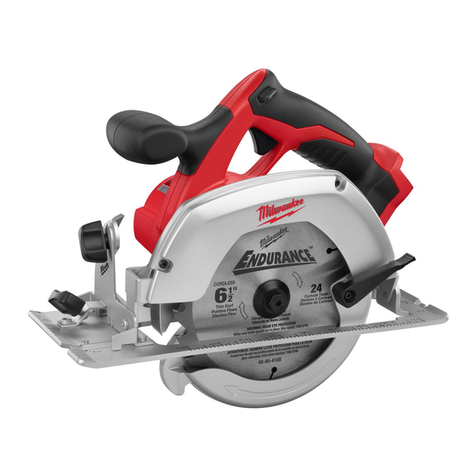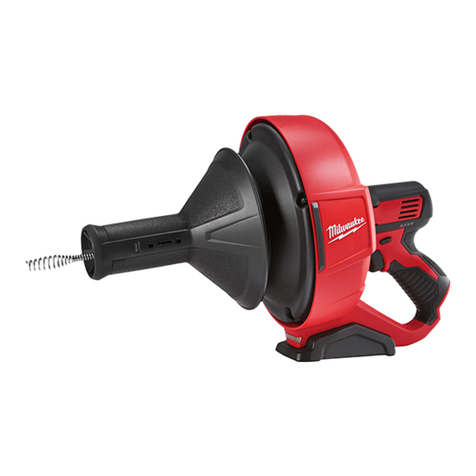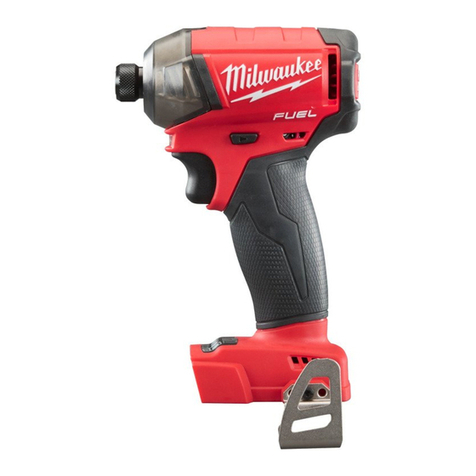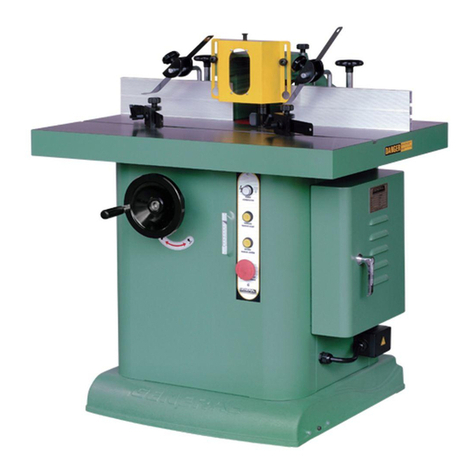
45
•When battery pack is not in use, keep it away
from other metal objects, like paper clips, coins,
keys, nails, screws or other small metal objects,
that can make a connection from one terminal
to another. Shorting the battery terminals together
may cause burns or a re.
•Under abusive conditions, liquid may be ejected
from the battery; avoid contact. If contact ac-
cidentally occurs, flush with water. If liquid
contacts eyes, additionally seek medical help.
Liquid ejected from the battery may cause irritation
or burns.
•Do not use a battery pack or tool that is dam-
aged or modied. Damaged or modied batteries
may exhibit unpredictable behavior resulting in re,
explosion or risk of injury.
•Do not expose a battery pack or tool to re or
excessive temperature. Exposure to re or tem-
perature above 265°F (130°C) may cause explosion.
•Follow all charging instructions and do not charge
the battery pack or tool outside the temperature
range specied in the instructions. Charging
improperly or at temperatures outside the specied
range may damage the battery and increase the risk
of re.
SERVICE
• Have your power tool serviced by a qualied
repair person using only identical replacement
parts. This will ensure that the safety of the power
tool is maintained.
• Never service damaged battery packs. Service
of battery packs should only be performed by the
manufacturer or authorized service providers.
SPECIFIC SAFETY RULES
•Always assume that the tool contains fasteners.
Careless handling of the stapler can result in unex-
pected ring of fasteners and personal injury.
•Do not point the tool towards yourself or anyone
nearby. Unexpected triggering will discharge the fas-
tener causing an injury.
•Do not actuate the tool unless the tool is placed
rmly against the workpiece. If the tool is not in con-
tact with the workpiece, the fastener may be deflected
away from your target.
•Disconnect the tool from the power source when
the fastener jams in the tool. While removing a
jammed fastener, the tool may be accidentally activated
if it is plugged in.
•Use caution while removing a jammed fastener.
The mechanism may be under compression and the
fastener may be forcefully discharged while attempting
to free a jammed condition.
• Do not use this tool for fastening electrical cables.
It is not designed for electric cable installation and
may damage the insulation of electric cables thereby
causing electric shock or re hazards.
•Use only those fasteners specifically recom-
mended. Fasteners not identied for use with this tool
by the tool manufacturer may result in a risk of injury
to persons or damage to the tool.
•Prior to each use, check workpiece contact and
trigger for correct operation. Do not disassemble or
clamp parts of the workpiece contact, trigger, or driv-
ing mechanism. This will cause unexpected actuation,
resulting in serious injury.
•Do not engage in horseplay. The discharged fasten-
ers are projectiles capable of causing serious injury.
•Do not remove, tamper with, or otherwise cause
the tool operating controls to become inoperable.
This will cause unexpected actuation, resulting in
serious injury.
•Do not operate a tool if any portion of the tool oper-
ating controls is inoperable, disconnected, altered,
or not working properly. This will cause unexpected
actuation, resulting in serious injury.
•Always keep hands and body away from discharge
area of the tool. Never attempt to clear a jammed
workpiece contact by grasping the discharge area of
the tool. Fasteners discharged from tool can cause
serious injury if they contact hands or body.
•Do not drive fasteners close to the edge of the
workpiece. Fasteners can slip off corners and edges
or penetrate through thin material, making them pro-
jectiles capable of causing serious injury.
•Use the tool only for the intended purpose. Do not
abuse the tool. Do not use as a hammer, stamp or en-
grave information onto parts, drop or impact the tool or
otherwise apply excess force to the tool in use. Do not
mount the tool to stands or modify it for stationary use.
•Maintain labels and nameplates. These carry
important information. If unreadable or missing,
contact a MILWAUKEE service facility for a free
replacement.
•
Some dust created by power sanding,
sawing, grinding, drilling, and other
construction activities contains chemicals known to
cause cancer, birth defects or other reproductive
harm. Some examples of these chemicals are:
•lead from lead-based paint
•crystalline silica from bricks and cement and other
masonry products, and
•arsenic and chromium from chemically-treated
lumber.
Your risk from these exposures varies, depending on
how often you do this type of work. To reduce your
exposure to these chemicals: work in a well ventilated
area, and work with approved safety equipment, such
as those dust masks that are specially designed to
lter out microscopic particles.
SYMBOLOGY
Volts
Direct Current
Read Operator's Manual
WARNING Risk of electric shock. Do
not use near electrical wires
Always wear eye protection
WARNING Keep hands away
UL Listing for Canada and U.S.
Installing/Removing Fasteners
Always remove battery pack before
changing or removing fasteners.
Always wear safety goggles or glasses with side
shields.
To install fasteners:
1. Remove battery pack.
2. WARNING! Always point the tool away from yourself
and others when installing fasteners. Failure to do
so could result in injury.
3. Pinch the magazine latch and pull magazine out
from tool.
4. Insert the fasteners into the magazine channel.
The fastener legs should point outwards away from
the tool body.
WARNING! Use only recommended
fasteners of the correct type and size. Other fasteners
could result in tool malfunction, leading to injury.
Magazine
latch
Magazine
Magazine
channel
5. Push the magazine back in until it snaps closed.
To remove fasteners:
1. Remove battery pack.
2. WARNING! Always point the tool away from yourself
and others when installing fasteners. Failure to do
so could result in injury.
3. Pinch the magazine latch and pull magazine out
from tool.
4. Remove the fasteners.
SPECIFICATIONS
Cat. No...................................................... 2447-20
Volts.............................................................. 12 DC
Battery Type .................................................M12™
Charger Type................................................M12™
Recommended Ambient
Operating Temperature ......................0°F to 125°F
Staple Type ..................3/8" Crown Staples (T-50®)
Staple Size ....................1/4" (6 mm), 5/16" (8 mm),
3/8" (10 mm), 1/2" (12 mm), 9/16" (14 mm)
FUNCTIONAL DESCRIPTION
1
8
5
6
3
7
2
4
1. Workpiece contact bracket
2. Staple exit indicator
3. Power adjustment
4. Battery gauge
5. Trigger
6. Battery bay
7. Belt clip
8. Magazine
ASSEMBLY
Recharge only with the charger
specied for the battery. For spe-
cic charging instructions, read the operator’s
manual supplied with your charger and battery.
Removing/Inserting the Battery
To remove the battery, push in the release buttons
and pull the battery pack away from the tool.
Always remove battery pack before
changing or removing accessories.
To insert the battery, slide the pack into the body
of the tool. Make sure it latches securely into place.
Only use accessories specically
recommended for this tool. Others
may be hazardous.
